

Altered States, Part 2: Breakage, tears, and fears, but ultimately a success story

“Altered States"
(or How I Spent My Summer Vacation)
Part 2: Sweating It Out at Quaker City
Quaker City Dragway loomed ahead on the highway, beckoning us to come forward and try our luck. My official NHRA licensing procedure would be starting today in Frank and Linda Mazi’s BB/Altered Opel GT after two days of intense practice. We played hide and seek with rain clouds throughout the hour and a half drive from the Mazi’s house, where I had been staying for the past week, and rolled on down the road, trailer in tow.
It had been almost a week ago that I last sat in the fire-breathing supercharged Opel, screaming down the track in Norwalk en route to exceeding my personal-best quarter-mile runs by almost five seconds and 50 mph (claiming the Dragster staff record in the process from John Jodauga’s 9.77) with a 9.24, mid-140-mph run on just my fourth full pass with the temperamental machine. But that was a week ago. And that was practice. But this … this is for keeps.
The NHRA Competition Licensing procedure requires one half-track shutoff pass, three moderate runs, and two full passes on at least two separate days. Because Quaker City is not running an E.T. program today, we will be able to put down the shutoff and two moderate runs and come back on Sunday for the one more moderate and two full runs, when the starting-line traction will be aided by Quaker City’s regular bracket program.
The last full run made is supposed to be within approximately 10% of the national record for the class, meaning that with the 8.15 BB/A record (since bettered to an 8.10), I’ll have to run around 8.96 or so to meet the requirements (the 10% figure needed is just a target to shoot for, so if you miss by a couple of hundredths or so there should be no problem). Having made my 9.24 effort on a total backpedal in second gear (after getting a look at Mr. Guardrail), we are confident that a full pass will produce at least the desired 8.90, if not better.
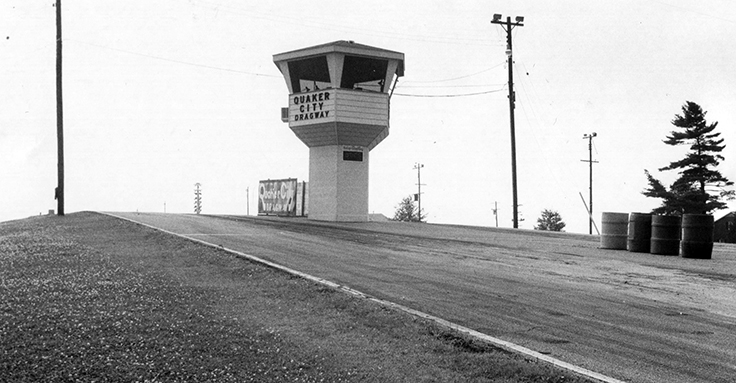
We set up camp in the finely manicured Quaker City pit area and unhooked the trailer to scope out the facility. It is here that I get my first look at “the hill,” Quaker City’s fabled burnout area. Basically, the burnout area/bleach box is two-thirds of the way up a 30-degree slope from the staging lanes to the starting line. Pulling into the bleach box, only the top two bulbs on the Christmas Tree are visible until you crest the hill and come up onto level ground. The back edge of the concrete launch pad sits right at the lip of the hill, making for an interesting setup. Oh boy, as if burnouts with the car weren’t dangerous enough, now I’ve got to do them uphill …
We hop into the crew cab and crawl over the racing surface at 5 mph, scanning the track for debris. The Mazis practice this ritual religiously, especially when running testing sessions on a non-meet day. The last thing we need is to blow a tire on some broken headlight that would send our “unguided missile” (as Frank refers to the car during the first part of the run) into unwanted gyrations.
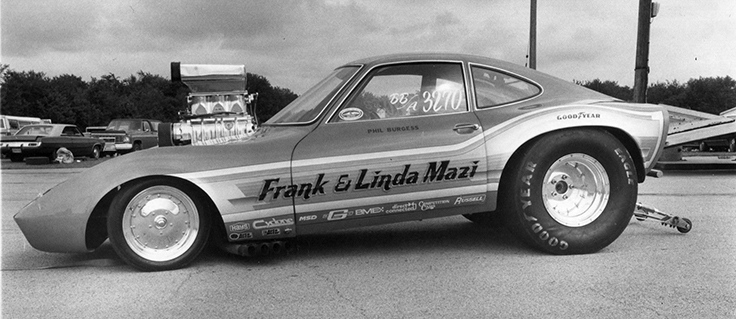
The Mazis thought of everything, including "lettering" my name on the door (stick-on letters, but who cares?)
Butch Osmon, who will provide the second licensed driver’s signature (along with Frank) to my licensing forms, arrives as we finish scouring the track. Track owner Dick Mossey also drove up to where we are getting set to unload the car. Both Osmon and Mossey had run through rain near the track, and the sky has darkened considerably during the 15 minutes we’ve been at the track. Then, it starts to rain — hard. It is clear we will not be making any runs today. We lock up the trailer and head for home. We’ll be back tomorrow.
What this one-day shift of plans has brought on though is the move of the full runs to Monday night after Frank gets home from work. The traction will not be at the same peak as if cars were running that day, but it should still be good enough to hook up for a decent run. Besides, the next weekend is the Popular Hot Rodding Championships that the Mazis want to attend, so we have to wrap up all our business before then.
Sunday’s weather is a vast improvement over Saturday, and the line of bracket cars waiting to get into the racetrack extends out onto the highway. Once inside, we set about unloading the car so we can be one of the first cars on the track in case the weather should go bad again. The first order of business is the mandatory “blindfold” cockpit-orientation test, which checks the driver’s ability to find the necessary controls without looking to ensure that, should an emergency arise, the driver will be able to get the car stopped and shut off no matter what.
The cloth bag from my Simpson helmet will serve as the blindfold, and Butch will administer the test. I take 10 minutes beforehand to familiarize myself with my normal run procedure … brake, shifter buttons, water pump, ignition, ‘chute release, brake, shifter buttons, water pump, ignition, ‘chute release. OK, we’re ready.
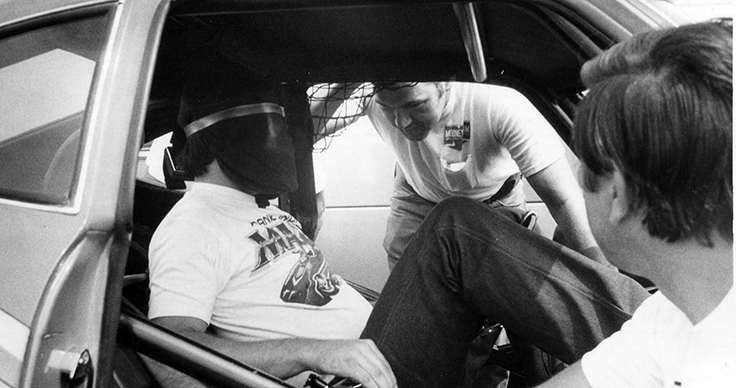
In the dark, I listen to Butch. He immediately throws me a curve, “Fuel shutoff.”
Fuel shutoff! What!? I forgot all about the fuel shutoff!
Fortunately, the fuel shutoff is hard to miss even groping around, and I reach out to where I think it should be and breathe a sigh of relief as my fingers slip around the T-handle. Although the fuel shutoff is not used during the course of a normal run, I should know where it’s at, but that thought hadn’t occurred to me in my preparation. Butch bounces back and forth between the controls a half-dozen times until he’s positive I know the controls inside and out (Funny man Frank called out “Reverse” one time which met with an “Oh will you stop it!” from Linda. A million laughs, huh?).
When it’s clear that Butch is done, I slip off the makeshift blindfold and look to Butch. “You failed,” he says deadpan. “Forgot to buckle your belts. I got failed for that once.” Tense moments follow. Ah, he’s joking … I think. He signs the form. Whew! On to the next step.
The motor is fired and the ‘chute packed in short order. After the inspection by track tech director T. Biggins, we tow up into the “hot car” lanes and wait. Come 12:30, the signal goes out that we are ready to race, and we will be the first car out.
Even though this will only be a half-track shutoff pass, Frank has drilled it into my head that I am to follow the exact same shutdown procedure that I would follow if I had made a full run. “I don’t care if you drag the ‘chute the length of the track. You need to have the shutdown procedure ingrained in your head so that it becomes instinctive,” Frank lectured, “because when you’re in trouble and really need to get the car shutdown, you’re not going to have the time to think about it. That’s why we do it every time.” Makes sense to me … but I have to admit that it’s gonna look plenty dumb to go out and pull the ‘chute at half-track, but he’s the boss, and we’ll do it his way.
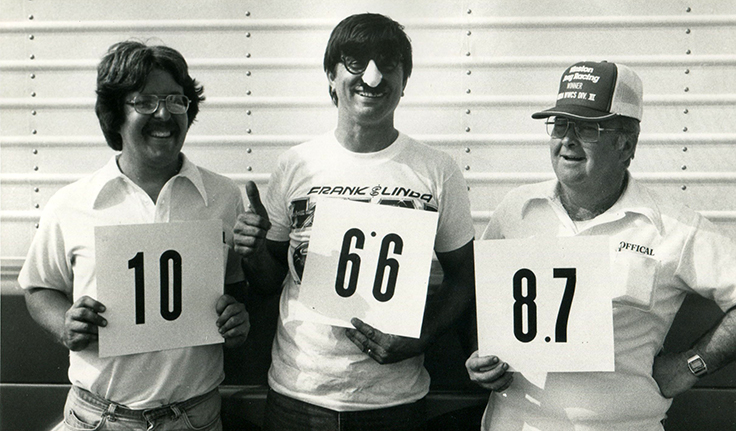
THE JUDGES: Responsibility for judging my license runs were, from left, local racer Eddie Tomaskovich, Frank, and track official T. Biggins.
On goes the firesuit and I clamber over the bar that runs along the door and plop down into the seat. Curious eyes peer over at us as I buckle up and turn on the air bottle. Everything in a slow, methodical pattern. The butterflies are doing laps in my stomach as I pull the hood over my head. Frank gives me an encouraging slap on the shoulder as the helmet goes on. Gloves next, I feel the controls. Yep, still familiar. The helmet, once in place, serves as more than a safety device for my head, acting as a psychological barrier between the elements outside, muffling the roar of the engine, encapsulating the driver in a sub-world all his own.
The motor lights, and Frank runs for the top of the hill to guide me into the burnout. The 100-yard drive to the base of the hill and up toward the bleach box is the last mental adjustment period before business. It’s a very exciting time but also a time strangely all to yourself and your thoughts. Plunk, plunk, plunk and the car is in fourth heading up the hill for the burnout … a very peculiar feeling to be driving up a hill to run.
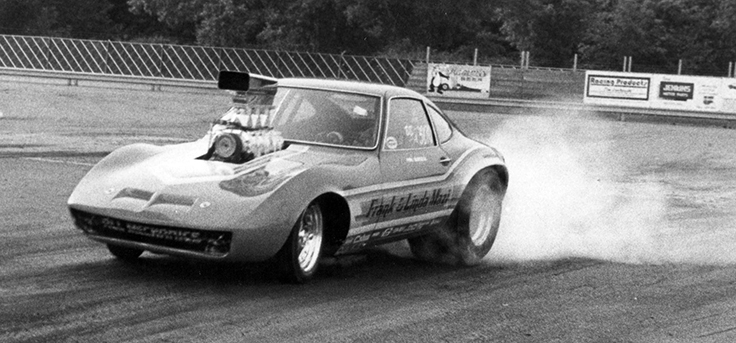
Burnout. Back up. Feeling confident again, like I never left the car.
The short six-day span between drives had left me feeling out of touch with the controls, but in a rush, it all comes back now. Frank directs me back, back, back … until suddenly I find myself on the downhill slope again. Brake on with the right hand, clutch in … wait a minute … how am I supposed to get the car in forward again when my right hand is holding the brake?! Try with the left hand, reaching across my body … no, can’t get enough leverage … OK, hold the brake with your left hand and move the right hand to … whoa … I’m rolling backward… right hand back on the brake … think! … where’s Frank? … try again with the left hand … nope not enough strength … try again holding the brake with the left hand hard … OK, she’s not rolling … use your right hand for the shift lever … it’s stuck … let the car roll a few inches and try it again … still won’t budge … ah, here comes Frank … go ahead, try it yourself … he can’t get it to move either … must be the angle of the hill … Frank says whack the throttle once and roll the car back a little and try again … still no good … temp gauge is resting on 170 degrees still rolling backward … I’ve got to almost be back into the water by now … Shut if off? … OK … damn!
The minute the car was back on flat land, the lever pops right into forward, so it’s safe to assume that the pitch of the hill had the trans a little out of kilter, making it almost impossible for the cogs to engage. You can be sure I won’t ever back up that far again … I’m staying on level ground from now on.
We tow back to the pits, and I’m doing my best to be inconspicuous from the stares of the people that must surely be thinking that the driver of the car must be lame … “Ha! Couldn’t even get it back into gear,” they must be saying. Me, I’m trying my best to act like I’m not the driver … hey, Frank, wanna steer this thing back to the pits?
On that high note, Butch announces that he must leave for a prior commitment, so the call goes out for another Class A licensed driver to sign my papers. Enter Eddie Tomaskovich, racer and Quaker City official who volunteers his judgeship for the duration of my licensing.
Personally, I’m feeling very humbled. The aspirations of going out and impressing the fans and announcers with my superior handling talents have been washed out.
An hour later we’re back in line. Personally, I’m feeling very humbled. The aspirations of going out and impressing the fans and announcers with my superior handling talents have been washed out.
“You OK?” Frank asks as I sit sulking on the tailgate. Sure, just great. First I make a fool out of myself on the hill and now I gotta go out and pull the ‘chute at half-track like I’m scared or something … for about a half-second I think about not pulling the ‘chute and just coasting through the traps and telling Frank I forgot. I say “for about a half-second” because I know what Frank’s reaction would be when he finally caught up to me at the finish line … besides, he’s right, if I get in trouble I want to be ready.
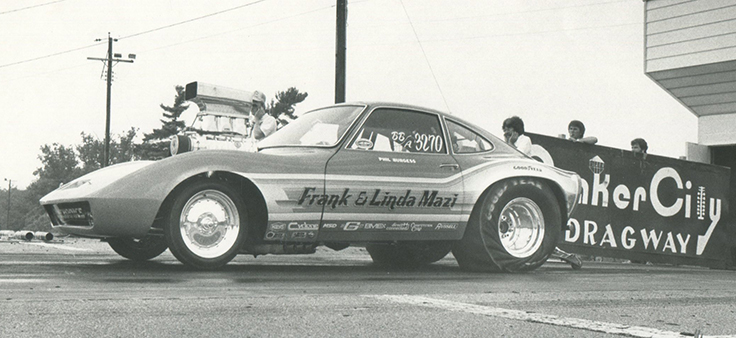
The burnout goes fine and we back up and stop well before the edge of the hill. Being so close to the starting line, my dry hop carries me into the staging beams where I sit deep-staged. Better back it up … oh I bet that looked dumb, too. Stage. Blast off. Before I know it I’m in third gear and the car is ripping. I punch fourth and reach up and hit the silk and the ignition. Usually I leave the clutch out and coast down on the motor and trans, but somehow I feel that stopping the car isn’t going to be a problem on this run.
With the 'chute out and the clutch in, I coasted across the finish line at 35 mph with an e.t. of 15.47.
Right after the finish line at Quaker City, the shutoff area slopes uphill and kills the little forward momentum I’ve still got. The car stops on the track, 30 feet shy of the first turnoff. Boy, I bet this looks even dumber than all the other things I’ve done … now I’m blocking the track … what a rookie!
The window net and the harness fight me as I try to get out to the car and grab the ‘chute so we can get the hell out of the way. Looking back at the starting line, two cars are waiting for me to get out of the way so they can run. This is beginning to look like a comedy of errors … only I’m not laughing.
Again I feel like skulking back to the trailer and hiding — which is exactly what I do. After hanging the ‘chute out in the rear trailer door (“The driver’s job,” says Frank. OK, as long as I don’t have to pack it), it’s flat out on my back on the cold steel floor of the trailer. Frank sauntered in. “I know you feel pretty dumb right now, but you did what I asked you to do, and I’m grateful for that. You did a good job.”
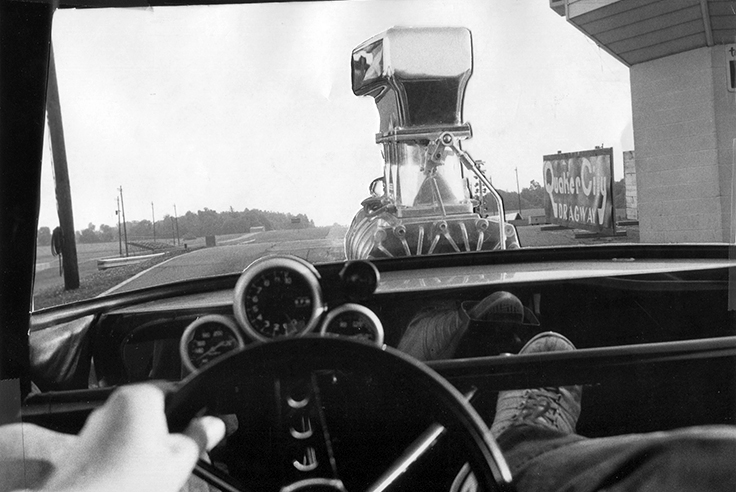
Here's kinda the way it looked. I say "kinda" because this is a mashup of two photos I took, one from inside the car in the pits and one standing on the starting line. This was before PhotoShop so I cut out the windshield (with an X-Acto knife) of the pit shot and taped it atop the other. When the story came out, Frank told me he was pissed that I had snuck a camera into the car for a run, until he noticed the tennis shoes, jeans, and no driving gloves.
Lying there on the floor of the trailer, trying to gather all my thoughts, I replayed the run in my head. Boy, did I feel small at the finish line. And then my pal and Quaker City track announcer Leo Taugher came by with an offhand remark about what I’d shown them so far … it was enough to make me want to hide. But self-pity never has gotten me anywhere before, so I mulled over the positive side of things: the run had been a strong one until I shut it off; I survived another uphill burnout; I was feeling comfortable with the car. I’d show ’em on the next run … I’d show ’em I know what I’m doing. Over and over again, I plotted the upcoming run until I was sure of its outcome, and then I got up, dusted myself off like a fighter getting off the canvas, and stepped out of the trailer.
“Well, he is still alive,” came the friendly greeting from my crew. They had, to their credit, left me alone to resolve my humility. “How are you feeling?”
“Great. Let’s go get ’em!” We hooked up the car and towed back to the staging lanes.
The sun had finally come out, as if in accordance with my renewed confidence in myself and the project at hand. Although the firesuit is plenty stifling to wear for long periods, I’ve decided to be in the car with the suit on well before we’re called. Part of the problem on earlier runs had been the rushing around when we were called, to suit up and get buckled in, leaving little time to get really acclimated with the car and get a good mental attitude.
When we are finally called, I am so ready … perhaps more ready than I’ve ever been to this point. Adrenaline is flowing like a dam just burst and as the motor lights, I get another surge.
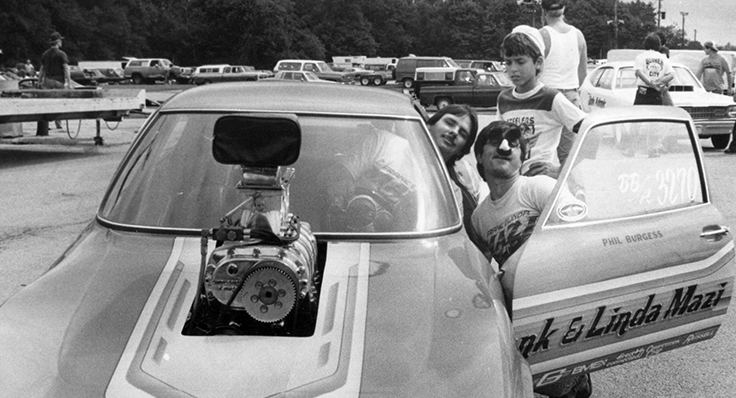
Frank tries to cheer me up with those damn glasses-and-nose. Looks like it worked.
The car further aids my good feelings with a nice burnout. Working together in harmony, the car and I seem to have come to terms: I do everything the way it’s supposed to be done and the car will be nice to me. The car hooks up beautifully on the launch, carrying the front tires a few inches off the ground and just flat haulin’ ass for the other end. An incredible sensation of great speed is melded with a slow-motion feel to my inputs, as for the first time I find an opportunity to glance at the tach and the oil pressure gauge between third and fourth gears. For the first time since this whole project started, I feel that I’m in charge of the car instead of the other way around.
In top gear I have to remind myself that this is supposed to be a moderate run, so I ease off the throttle and pull the ‘chute early, the motor going silent before the first light. The timers stop at 9.29, 145 mph, an incredible figure to me, considering the early shutoff. The ‘chute blossoms with a jerk and the car slows quickly with the combined effects of the engine brake, ‘chute, and rear brakes (the car has no front brakes).
Coasting through the shutdown area, an immense flood of emotion comes. What exhilaration! The calm and quiet of the car sailing to a stop with just the wind buffeting around the car allows the sensations of the run to catch up with you. The thrill of a job well done and the thrill of flirting with danger mix for a euphoric feeling like none I’ve experienced.
The seat belts and window net don’t even fight me for the first time in eight runs, and I can hear the Mazis blasting the horn of the truck from halfway down the track.
“Would have been a low 8.80 or high 8.70 at 155,” says Frank. He’s run the car for so long that even on a shutoff he has to believe — hell, I want to believe — that I could have gone an 8.70 at more than 150 mph.
"The car draws stares and pointed fingers from everyone it passes. For the first time here at Quaker City, I’m proud to say that I was the guy that just powered down the track in this machine."
There’s no problem with me wanting to be the one in the car towing back through the pits this time, as the car draws stares and pointed fingers from everyone it passes. For the first time here at Quaker City, I’m proud to say that I was the guy that just powered down the track in this machine. We’ve turned the corner and things look to be all downhill from here on in.
The third run of the day, my second of three moderate passes, is a near clone of the run before it, but I stretch the gear changes a little more this time, wringing out more rpm than ever. In fact, third gear is a little too much and the rev limiter kicks in and the car starts to miss, which is my cue to shift to fourth.
From fourth gear, it’s just a short span until I click it early again and coast through the traps with the ‘chute out of the motor silent. With a 9.21 and a speed of 142, it’s clear that, despite bouncing off the rev limiter in third, the run was even better than the previous one. The lower trap speed would indicate that I shut off even earlier than the run before, making it probably a low 8.70 effort had it been a full run.
As Porky Pig would say, “A-be-de, A-be-de, a-be-de … that’s all, folks.” At least for today. We grabbed all of Frank’s hand tools out of the trailer (so that Frank could work on the new motor for the Pop Hot Rod Meet and the NorthStar Nationals if it rained tomorrow) and headed for home, confident of a victory.
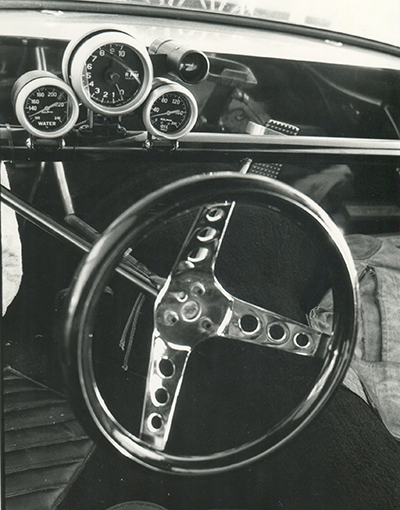
Not that I had assured myself I was in complete mastery of the car mind you … there was still plenty of good old-fashioned respect rooted deep within me for the car, as I knew that at any moment it could become a demon and give me more than I could possibly handle. “The car must like you,” confided Frank, “because she’s been nothing but sweet to you. I hope you can handle her as well when she gets ignorant.”
Dawn and I spent Monday afternoon trying to find a clinic where I had an appointment to get my FAA Type III physical examination. Glancing at the form in my sweat-drenched hand, I was not looking forward to this scrutiny at all. Granted, I’m no picture of absolute health (I’ve got my vices after all like anyone else), and I should be able to pass any physical — but this form was telling the doc to do everything but check my oil. More than 60 items were listed for approval, and I could see how long this was going to take. Oh well.
We couldn’t find the clinic. Sure, we know it’s the Erieside Clinic which means it should be right near Lake Erie, but we couldn’t find it until it was half an hour past my appointment. Could I come back Wednesday, the nurse wanted to know? Sure, no problem. I’ll be back right after I finish my licensing runs. No sweat.
Frank is home from work by 4:30, so we all hop into the truck and head for Quaker City. Expectations are running high, although we’re aware that traction will not be absolutely the best we could hope for … oh well, I’ll settle for an 8.70. Things were just great until halfway to the track, Frank lets a few choice expletives loose. “What?” we all ask. “We forgot the tools back home!” Do you suppose this was an omen?
We’re pushing it for time anyway, as we want to get in our last three shots before darkness falls, as Frank has told me I don’t want to be driving this car at night until I’m really dialed in. No arguments here. “Maybe we can borrow some tools at the racetrack,” Frank says optimistically. “Let’s go on.”
I think it was John Wayne in one of those cliched war films that said, “War ain’t exactly civilized business, y’know.” Amen.
We set up shop at the track, but the best we can scrounge up toolwise is a spark-plug wrench and a 9/16 open end. Let’s see, if nothing goes wrong, we should be OK: spark-plug wrench for the plugs and a 9/16 for draining the water. Sparsely prepared, but prepared nonetheless. I think it was John Wayne in one of those cliched war films that said, “War ain’t exactly civilized business, y’know.” Amen.
Run No. 4: a good burnout puts me right back in touch with the car, as if I’d never left it. The ritual of operation for the car has almost gotten to the point where I don’t have to even think about what I’m doing. A regular veteran. But that kind of thinking has resulted in more than one wrecked car, I tell myself, as I lope on back after the burnout, so mellow and deflate that ego of yours.
Dry hop. The car squirts a little before hooking up and the throttle jams open at 4,000 rpm. I wing it once. Nothing. Again. Still nothing. Frank motions me to whack it again to unstick it. I do. It doesn’t. Finally, I use the toe strap on the throttle pedal to bring it back and the idle drops down to the normal 1,100 range. OK. Set.
Moving into the stage beams, anticipation was always high. Here was the big payoff. This is what all the butterflies and practice and the burnout and the dry hops were all for.
The last yellow on the Tree shines bright as I set the reaction in motion with a lift of the left leg. The massive rpm level is transferred into the clutch and the hand leaves the brake and the car is already starting to move. This time it will slip the tires on the cold starting line … other times it will lift the nose of the Opel a tad like a stallion rearing up in battle. The charge is on.
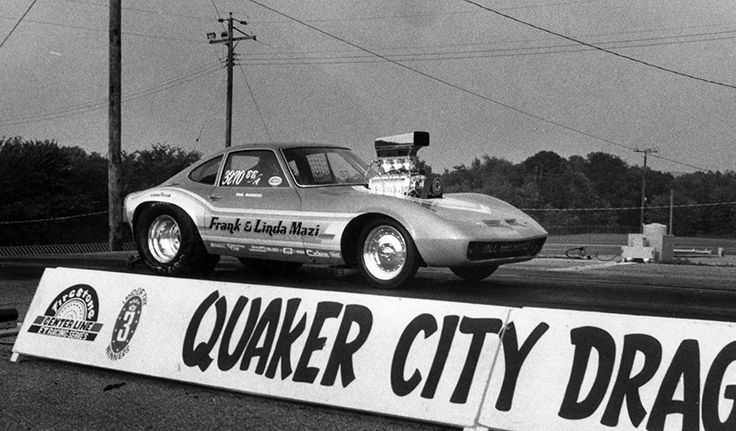
After the initial slip, the car pulls hard and I bounce it off the rev limiter in third again, this time the result of paying too close attention to the tach and not enough to the sound of the motor. The tach will sometimes bounce wildly around the scale, and this was one of those times. The brief stutter of the motor is my key to punch the next button. The car never ceased to amaze me with the way it pulled strong through all the gears and the temptation at this point is to leg it all the way through … but no, this is a moderate run, so I ease off and pull the ‘chute and hit the kill switch.
Caught up in the nirvana stage of the run as the car slows and the recollections speed up, I’m at the first turnoff before I realize that the motor is not yet off. Disgusted, I flip the switch again and the motor winds down to off. My self-assuredness was no doubt the cause of this, as the shutdown procedure had become old hat in that I thought I had mastered it with a subtle pull of the lever and a flick of the finger as Frank had told me he does. I guess I wasn’t quite that good yet.
“Squirted around a little, huh?” were Frank’s first words to me at the end. “Killed the run by a tenth and a half. You ran 9.40, 143 so I figured it was pretty equal to the others. Good job.” My head swelled at that compliment. He knew I knew I got on the limiter. He knew I knew that I hadn’t killed the engine on time, but he also knew he didn’t have to tell me. Keeping the car under control on the slippery track had told him I learned my lesson well. Running machine-like consistency on two separate days was a marker on my side of the ledger.
Now the fun would begin … A full run. The only piece lacking was the “pumping up” of the blower from 1.7% overdriven to a higher level. This requires a pulley change, and because our tools were taking the day off in the Mazi garage, we would have to forego that boost and make do. I still felt that an 8.70 was solidly in reach with a good hook-up.
Up to the line we went for full run No. 1. We knew I could control the car under high eights, so let’s just cut ‘er loose and find out. Not since my testing in Norwalk more than a week ago had I made a full-out pass, so I was ready to drive it right to the finish line before I shut it off.
The burnout heightened my anticipation. Back up. Frank can sense that I’m pumped up and tries to calm me a little. Through hand signals, he checks to make sure the car is in forward and in first gear before I do my dry hop. He wants to make sure I get full advantage of the dry hop so I can tell how the car will hook. WHAAAAAA-wam — drop the clutch. The car hooks up better than the first time. Hmmmmmm, might be an 8.70 on this track after all. Stage … time for the big payoff again.
Steady … first bulb lit … easy … OK, second bulb on — it’s all yours, Mr. Starter … yellow, yellow, yellow, yellow, NOW! Alright! Nice leave, not much slippage … second gear — yeah! Third gear coming up … what was that?! Popping … might have been the ignition … car’s still pulling strong … fourth — maybe I can still salvage a good time … finish line … OK ‘chute! Ignition kill … OK … WHOA!
The minute the ‘Chute hit, I knew I was in trouble. The interior of the car was filled with smoke, obscuring my vision slightly.
The minute the ‘chute hit, I knew I was in trouble. The interior of the car was filled with smoke, obscuring my vision slightly. What the #@$¢*%! “Fire?” was my first thought as my hand leapt for the fuel shutoff. Just before I yanked the T-handle I noticed that the smoke was a bluish color. “Tire smoke?” was my next thought. “How could that be?” Then it came to me … “Oil … Damn, I must’ve ventilated the block … maybe a rod?” Four-letter expletives turned the cockpit even bluer. Then, a thought, “If I winged the block, there could be a fire, too, from the gasoline. Gotta get this baby stopped in a hurry!”
At 75 mph, I popped the belts and wriggled out from the once comforting hold. On the brakes hard, I felt no slipping, so I assumed that there was no oil under the tires … but how did all the smoke get into the car?
I was at once thankful for my firesuit and gloves and helmet, knowing that if the car was on fire, I should be able to get out without being scarred for life. The smoke was clearing as I neared the last turnoff, and at 10 mph I opened the door to clear the air, steering with one hand again. Quick like a jack-in-the-box, I was out of the car. No fire. No oil dripping out from under the car. Back downtrack, I could see the crewcab slowly working its way to me through a thin haze of smoke, still hanging in the air.
Sullen faces greeted me as the truck came to a halt. “What was that about?” I asked Frank, secretly hoping that it was a tire that had been rubbing on the body, but knowing all along it wasn’t.
“Another valve,” he half-sighed, half-grimaced.
“Didn’t you feel it?” Linda’s innocent question became a haunting accusation.
“No,” comes a timid answer. “When did it break?”
“Right off the line,” said Frank over his shoulder as he gathers the spent parachute in. “She was hurting all the way down.”
The realization of what I just did came creeping over me like a dark shadow. I had just pulled the stupidest of all stunts.
The realization of what I just did came creeping over me like a dark shadow. I had just pulled the stupidest of all stunts, driving the entire length of the track trailing a cloud of smoke. From the starting line, it must’ve been plainly evident, but from inside the car I saw nothing or felt nothing until the popping in third, which I had attributed to being on the rev limiter again. How foolish I must have looked to Frank and Linda and all the others who had gathered on this night to watch. What a rookie mistake!
“Hop in,” called Frank as he hooked up the car to the truck for the tow back to the trailer. It was the longest quarter-mile ride I can remember ever taking, as I sat solemnly in the cockpit and watched Frank and Dawn sitting on the tailgate in front of me, talking in low voices. The occasional glimpse of Linda behind the wheel of the truck in her side window painted another picture of despair.
An assembled multitude of people awaited our return to the trailer. Curious expressions and shuffled feet acknowledged my humiliation. Frank popped the top on a beer and stood looking at the engine. I leaned against the side of the truck, wishing I were anywhere but here.
“What are you going to do, fix it and come back tomorrow?” The question belonged to Biggins, the track tech director. “Will you need the track tomorrow?”
“I dunno,” my voice cracked. “It’s up to him,” I said, nodding a head toward Frank. I walked away. Everyone knew that next weekend we were supposed to leave for the Pop Hot Rod race … it looked like this dream had ended … or worse yet, turned into a nightmare (Quoting from the Book of Springsteen: “Is a dream a lie if it don’t come true, or is it something worse?” Food for thought).
Sitting on the damp grass, still in my firesuit pants, I wept like a child. Tears of frustration, tears of anger, tears of embarrassment.
I stalked off to the front of the trailer and some solitude. Sitting on the damp grass, still in my firesuit pants, I wept like a child. Tears of frustration, tears of anger, tears of embarrassment.
Besides my two reverse burnouts early in my training, this is the first “stupid” thing I’ve done. I feel like I’ve let them down and made a bad judgment call … Damn! Should have shut off. I should have known, but I haven’t been in the car long enough to sense when the car is really down on power … still, there are no excuses as far as I was concerned. I whipped off my T-shirt and dried my eyes.
Dawn and Linda both make passes at cheering me up, Dawn with a tale of similar breakage on a new moped and Linda with a cold beer. Soon, they move off, and my guilt returns. I never meant for it to be this way, I had hoped I could get in and out without damaging parts. Sure, the Mazis had signed a release absolving me from any responsibility, but there is still the pain of ruining something that doesn’t belong to you — and worse yet someone who has treated you so kindly and dearly and who you’ve grown to love like a second family. Sincere hurt-to-the-bone pain.

A voice piped up loud from the rear of the trailer. “Geez, my driver’s taking this harder than I am.” Frank. Always the first to break the tension. “Hey, Burgess … you gonna help us load up this car or what?” The mocking exaggerated voice brought a smile to my face.
Linda threw an arm around me. “Don’t worry about it. It’s not that big a deal. At least we’ve still got the car. You could’ve got oil under the tires and then we really would’ve seen what kind of driver you are.” The car is loaded, and I thank Eddie, Biggins, and Leo for their attendance at tonight’s debacle … hope to see you again soon. We’ll see.
With the trailer hooked up, Frank rams the truck into gear and looks over his shoulder at me, looking out the window from the back seat. “This is another part of drag racing you’re gonna learn about … it’s called ‘the ride home.’ Sometimes it’s quiet for a long time … sometimes we can’t stop talking … or arguing. We’ve been here lots of times before.”
Things finally loosen up enough to where we can talk about it, but a knot keeps building in my throat and my eyes threaten to well up with tears again as we rehash the incident.
What it all boils down to is probably three things: first, the intense heat from the combustion chamber can melt the valve heads off. It’s happened to them before (and was most likely the cause of my first valve breaking back in Part I) even with their titanium valves; Secondly, the valves do have a lot of runs on them, probably in excess of 100; lastly, my failure to turn the motor off quickly on the run before was a contributing factor as the valve superheated with the flow of fuel shutoff (with the gas pedal not down) and the engine still firing.
The first two I can take no blame for but the third is clearly my fault, and then the burden of guilt rests squarely upon my shoulders, although no one is saying so. It is this that finally allows me to accept that maybe we should give this project up.

Hint: It's not supposed to look like this ...

Or this.
How many times have I written a race report where so-and-so dropped a valve or wasted an engine or holed a piston with it being no more to me than a few strokes on a typewriter key? How impersonal it all seems until it happens to you and you realize the anguish of breakage. Another new insight is gained by this heretofore “seen it all before” writer.
That night, laying safely in bed, the scene replayed over and over in my head. What if the car had been on fire? Would I have reacted differently? Would I have heard, “Phil, this is Fear speaking … you are in trouble now.” Not that I wasn’t scared in the milliseconds after the ominous cloud of smoke invaded the sanctity of my cockpit. The car had never caught fire before, but there’s always the first time. (Humorously enough, my very first time in the car to warm it up at the Molson Grandnational, the headers caught fire after Frank poured too much fuel into the injector on start-up. It was the only time fire had ever been on the car, and jokes flew about what a bad luck driver I would be).
So, another valley in my rollercoaster ride to drag racing stardom had been reached. After emotional highs the day before, things were never bleaker for the future of my license. Tomorrow, Frank would start work on the car for the Pop Hot Rod race. Fate had dealt me a cruel hand. Dawn and I (mostly Dawn) stripped the top end down. Dawn will be taking the short drive tomorrow to Mr. Gasket/Hays to drop off our clutch with Bob DeVour, and Linda will be on the phone to Manley for a new set of titanium valves.
We spend the rest of the week in typical urban activities: a swim in Lake Erie, cruising the town to the accompaniment of the Mazi siblings’ raucous collection of heavy metal thunder (c’mon, what’s a Def Leppard anyway?), and just plain hanging out. On yeah, Wednesday was my return to Dr. Schick and the Erieside Clinic … I’d have to say that the ol’ doc probably knows me better than my mom (I said it was a thorough exam).
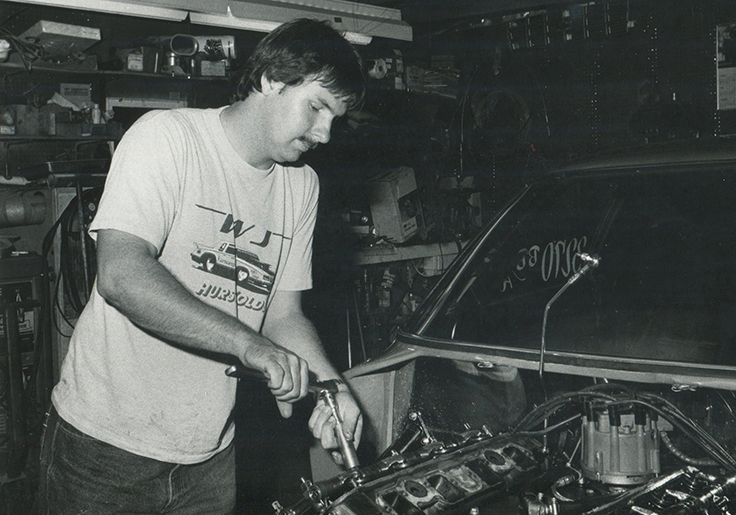
Phil working on the car. Or at least pretending to?
By Wednesday night, Frank and Linda announce that, no matter what, we will finish the licensing procedure, even if it means passing on the Pop Hot Rod race. Their sacrifice is great, as they haven’t missed that race in years, and I am deeply appreciative. There is also the possibility that we can get my remaining two runs in on Friday night and head out for the race that same night. But, by Friday night the car is still not back together, and we plan instead to return to Quaker City during their regular E.T. program on Sunday when the traction will be good.
Having an eleventh-hour reprieve for my license, the determination is even greater now than ever to do good, to make it worth the Mazis’ while for passing on the Pop Hot Rod race. There are new valves in the car that have been treated to aircraft-quality shotpeen process recommended by Bill Miller of BME. The clutch has been worked over by Hays and the scene is set. Action!
The “big blower” is now a little “bigger” than my last runs as Frank has made a pulley change to bring it up from 1.7% overdrive to 3.5 over in anticipation of quick times. We know I can run 8.90s with ease, and when Frank asks me what my new goals are, I tell him, “I want to run index” or more simply put, at least an 8.50, the current BB/A standard. While an 8.50 seemed a little too much to ask for, it was a nice goal to set my sights on, and the thought of pleasing Frank and Linda by running that quick I hoped would be my present to them for passing on the Pop Hot Rod race.
“The car will have some more power now,” instructed Frank. “Not a whole bunch more that you’ll really be able to notice it though. What will really strike you is that the car will be even more responsive off the line now.”
More responsive? The car already is bordering on instant power — how much better can it get? But hey, sounds good to me … I want to go fast … really fast.
Sitting on the tailgate watching Frank prepare the car, I am alarmed to notice that people walking in and around our pits are stepping on the shroud lines of the parachute as it is stretched from the car to its drying out spot inside the rear of the trailer. I am aghast. Hey folks, that’s my lifeline you’re stepping on there … the only thing between me and a faceful of trees at the finish line … show a little respect, huh?
Now, more than ever, it seemed that everything was going to have to be just right. Sure, I got the car stopped in practice once from about 120 mph without a ‘chute, but now we’ll be in the high 150-mph range where there is no margin for error and even less for malfunctioning parachutes. Even with eight full runs under my belt (and two short shutoffs), I know that I am not this car’s boss. Frank once told me, “The car is dumb, it needs your help to make it run fast.” Well, so far me and the ol’ Opel had been getting along real well. I’d tell it I was sorry I hurt its valves and it would make nice straight runs, but it was a team effort. So far the car had not shown me its ugly side by getting super crossed-up, but I am totally cognizant that this is still a dangerous car (or sport for that matter) whether you’re driving an A/SA or a Top Fueler, and this is not the car to get cocky in, as short-wheelbase high-horsepower race cars have disputed many a guardrail in their day.
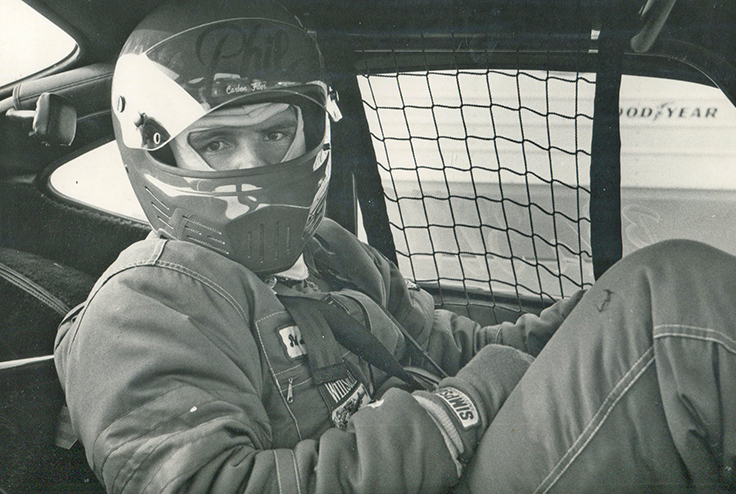
With a good deal of discretion still implanted in my mind, we suited up and headed for the staging lanes and the first of my two full runs. Again I told myself that “This is it,” what it has all boiled down to. I’ve got just two more passes left in this car to last me the rest of my life, so I want to make them both gems.
Rolling up the hill for the burnout, I was really beginning to enjoy myself. I was confident in my abilities with the car, and as long as it didn’t do anything wacky, I knew it was going to be a good pass. The burnout was a fun portion of the run … fun, but laced with an edge of caution just in case the car got ignorant. It kinda reminded me of the times when me and the guys would go out with our street cars in the rain and mash the gas — but this was just a tad different as the tires spun and grew, raising the car up and then shooting it forward when the tires finally grabbed hold. Yeeeee-hah!
Backing up carefully from the burnout, I thought about the Christmas Tree. Before my run I’d stood and watched the Tree count down, trying to understand Frank’s lecture on the last yellow bulb, and the different stages of that light glowing. I never realized it before, but if you watch closely enough there is a period of just barely lit, followed quickly by stages of brighter and brighter yellow before the bulb burned brightly and went to the green light. Of course, we’ve all been told that if you wait for green you’ll never win a race and you have to leave at the first hint of yellow or just before it went full brightness, but to study that intensely when it really meant something was a treat. And, unlike the stoplights of our youth where the green light was never predictable from intersection to intersection, you knew you could always count on the Tree doing the same thing time and time again … perhaps the only “for sure” constant thing in drag racing. Oh well, time to see if this homework will pay off …
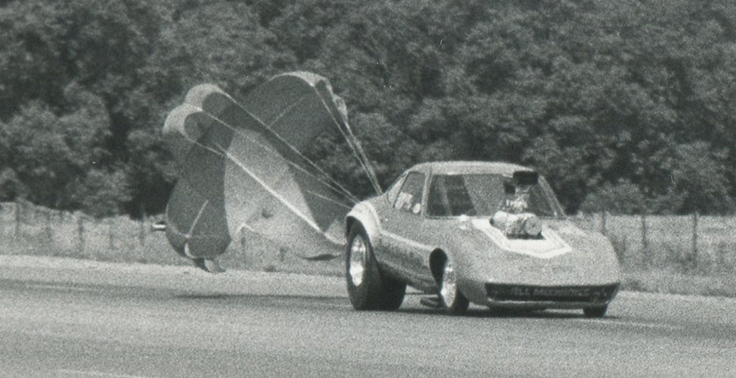
Dry hop! Not bad! Plenty stout, in fact! This, my friends, is gonna be bitchin’! Pre-stage. Stage. Time for blast-off. Here’s the payoff … yellow, yellow, yellow, yellow, little bit of yellow … little more … NOW! … great light … second gear … nice job … hold second a little bit … WHAM! Third gear … all right … sucking me back in my seat … yeah! … look at the tach … alright — look at the finish line come shooting up … death grip on the steering wheel with the left hand .. ‘chute release in the right … NOW! … pull the ‘chute … on the brakes … Wow, what a tug from the ‘chute! WOW! WOW! WOW! (I was a little excited).
Scrambling out of the car, I couldn’t wait to hear what I’d just run … damn did it feel good! Here comes Frank and Linda blasting on the horn and cheering. The truck is barely stopped before they all come tumbling out — Frank, Linda, Dawn, and the Mazis’ chrome man Jerry Tuttle (along for moral support) — and proudly announce to me: 8:64! Yippeee! Not bad … not bad at all.
Towing back down the return road swelled my head to where I didn’t think I’d be able to put it back inside my helmet again. People stopped and stared at the car and shook their heads in disbelief at the wild car before them. The time slip gave no speed because of a malfunction, but right there at the bottom was a number that impressed me – .570. my reaction time. Not great by national event standards, but better than I could ever have hoped for. On to my last run … and boy was I looking forward to it!

We pumped the blower another notch for my last run, from 3.5 to 5.6 over, and Frank cautioned me that this time, besides the added response (again?) I was going to feel a lot more power. With the car in this combination, Frank can run 8.30s all day, so there must be an 8.50 in this baby for me.
It seemed like just a short time before I was back in the car in the staging lanes, having spent the time between runs acknowledging the congratulations and good-luck wishes from some new fans. As the signal came down for us to fire it up, I buckled on the helmet and tried to remember which glove I’d been putting on first and marveling at how I had become somewhat superstitious during the course of my runs; I can see why there are very many superstitious racers with all kinds of little quirks to their routine that they don’t dare deviate from (Oh yeah, the left one goes on first).
The motor is fired, and as Frank sprints up the hill, I take these precious few seconds to gather some thoughts. My goals are two: run 8.50 and go 160 mph. My previous 8.64 probably carried a 156-157-mph tag with it, so with the increased power from pumping the blower, both goals don’t seem too unreasonable. I ease out the clutch and start toward my final run.
This is it, ladies and gentlemen, one last crack at everything – one more burnout, one more dry hop, one more chance against the Tree, one more foot-to-the-firewall, no-holds-barred, all-out effort; one more tug of the parachute, one more time slip. It was a little sad to think that this machine that I’ve grown to admire and respect and become a part of might never be under my semi-control again. But … there is, after all, one more run due me. Let ‘er roll!
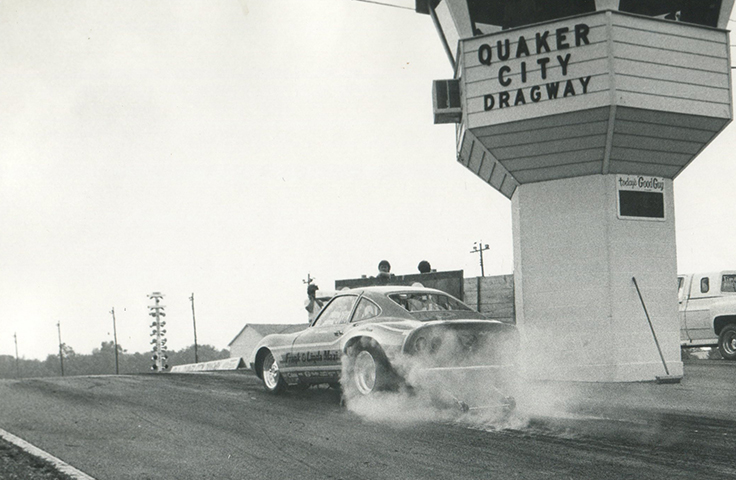
Up the hill once more, now totally unimpressed with it as I had been just a week ago. I’ll give ’em all a smoky burnout to remember me by too. With the clutch in, I stand on the throttle harder than ever before and drive it all the way to the crest of the hill with the tires blazing. Right near the end, the car starts a lazy left turn so I back out and de-clutch. Alright! Almost like Frank does ’em!
Backed up and ready for the dry hop, I can sense that the car has tons more power than any other run. For whatever reason, the dry hop was not as stout as the previous one … I dunno, maybe I was just being cautious or maybe intimidated — either way, it was nothing special.
I quickly staged, eager to make this killer run. I wanted to put everything through its paces exactly right to do the ultimate I could do. With both bulbs lit, I brought the rpm way up and the car crept forward just a shade and dropped the top bulb. This is supposed to be a perfect run, I told myself. I looked out my side window at Frank standing next to the track and motioned that I wanted to back up. He nodded yes. I wasn’t going to take any chances of a timing malfunction on my last pass. I backed up and re-staged.
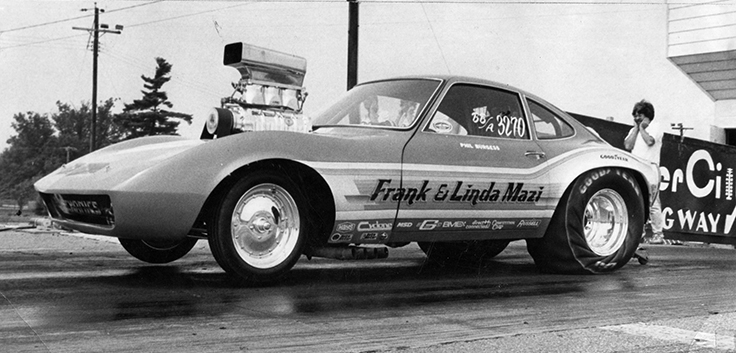
Like a shot I was off, dancing the front wheels half a foot off the ground and making tracks for the other end. Second gear came up so much quicker than ever before, but I punched it in time and started to wind out second, trying to feel the motor out as the tach was wildly bouncing around from vibration.
All too soon I saw the finish line approach and with a yelp of exultation, shoved the ‘chute lever forward and killed the ignition. A sharp jolt let me know the ‘chute was out, and with the wind whistling through the car, I knew it was over. Both relieved and disappointed to be finished, I made the last turnoff and jumped from the car to see Frank setting a new crew cab Low E.T. down to where I was.
Again the horn was blasting, so I figured that I must have exceeded one or both of my goals or at least bettered my 8.64. I gathered up the spent ‘chute as they neared, and Frank was the bearer of the good news. “160.71 mph!” he said and watched me beam. “What was the e.t.?” I asked quickly. “8.57,” said Linda. If they could have seen beneath my helmet, they would have seen my face sag momentarily at not running on the national index, but they also would have seen my lips moving as I proudly said, “I’ll take it!”

Like a triumphant warrior returning home, so was my feeling upon returning to the pits and our growing entourage. Hugs were exchanged all around, and Eddie, Biggins, Frank, and Dick Mossey all penned their names to my license form.
There was much joy in Maziville that night as we celebrated not only my imminent licensing but our survival. The next morning I put my license forms in the mail with the licensing fee and applied for a permanent number. Being licensed in Division 3 meant a number starting with “3” so I chose 3724, the last four digits of the National Dragster phone number.
A few weeks later at the NorthStar Nationals in Brainerd, Minn., Division 3 Director Keith Ferrell personally presented me with my license to officially make me a Class A NHRA race driver (unfortunately, as an employee of NHRA, I am not allowed to race in competition for fear of raising cries of favoritism).

So there I was at the NorthStars with my brand-new license in hand, sitting in the top-end bleachers with a group of happy-go-lucky fellers with a couch set up on a pipe rack on the back of their beat-up Ford truck. So, one guy says to the other, “Hey, wasn’t that Opel bitchin?” The others chimed in their approval. “Which Opel?” I asked. “That red one in the pits with the blower … man that is some neat car. How’d ya like to drive that thing!?” I didn’t have the heart to tell ’em … nor did I think they would ever believe me … to this day, I still have a hard time believing it myself.
But, as Top Fuel world champion Joe Amato said to me in the airport after the U.S. Nationals, “You’ve got the hook in real deep, huh?” he asked, sticking a finger inside his mouth to simulate a fish being hooked. “You want to go faster now, right?”
“You got it”, I said proudly.
“That’s the same way I got started,” he said with a gleam in his eye.
Maybe someday, I told myself. Maybe an Alcohol Dragster or Alcohol Funny Car next though. But someday.

Wow, that was fun. I know it was a long read, so if you made it to the finish line without wrecking, thanks a lot.
So, what happened next? Well, I never did get into another race car, but I got really close. Jim Head, fresh off his U.S. Nationals win earlier that year, offered me the chance to drive his nitro Funny Car, which seemed like a pretty major leap in experience, but I was 24 years old and game.
Unfortunately, we didn’t get very far into the plan beyond me warming up the car in the pits at the NHRA Finals in Pomona (thrilling nonetheless!).
A few years later, my longtime friend and Comp eliminator world champ Bill Maropulos offered me a seat in his B/Econo Dragster, and I was enthralled with the idea. A dragster sounded cool, and it was a lot safer than a nitro Funny Car (and even the Mazi Opel), but it was right around that time that I got married and inherited a stepdaughter, and Mrs. Editor didn’t see an equitable risk-reward for me feeding my Need for Speed, so it never happened either.
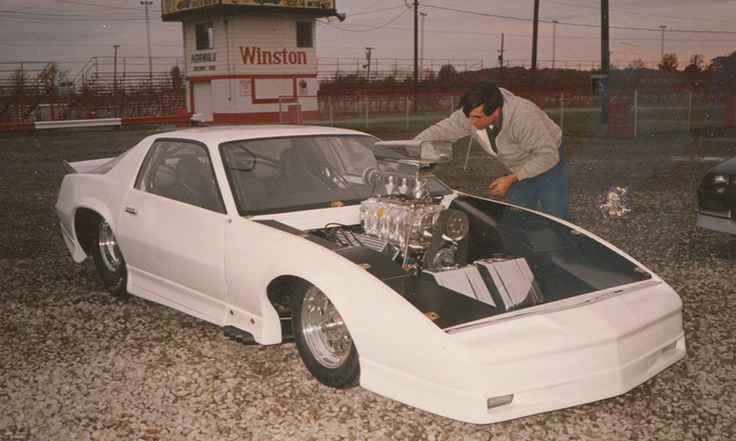
I stayed in close touch with the Mazis for years, returning to Ohio for all sorts of adventures, including the shakedown of Frank’s new BB/A Firebird (which at the 1986 U.S. Nationals became the first BB/A in the sevens using the same engine out of the heavier Opel). I’ll never forget Frank looping the car and creasing the guardrail during testing in Norwalk, where I had almost found the guardrail.

We’d go skiing together and Frank and I even tried hang-gliding, which almost got me killed. As inevitably happens, as everyone gets older, they set out on their own adventures. The Mazi girls all followed their life courses, Frank and Linda split up, and my extended family kind of scattered.
Despite her move to New Hampshire, I got to see Dawn quite a bit over the years as she and her husband Mark were regulars at the drags, shooting photos, making videos, and creating the Drag Strip Girl line of apparel. She recently returned to Ohio and now lives close to Frank. Wendy got married, started a family (she has two college-age daughters; sheesh, she was 14 when we met), and stayed close to home. Tammy moved to Las Vegas, followed later by Linda. (I got to see Tammy during the recent NHRA Four-Wide Nationals; Linda was busy moving, so we’re shooting for October.)
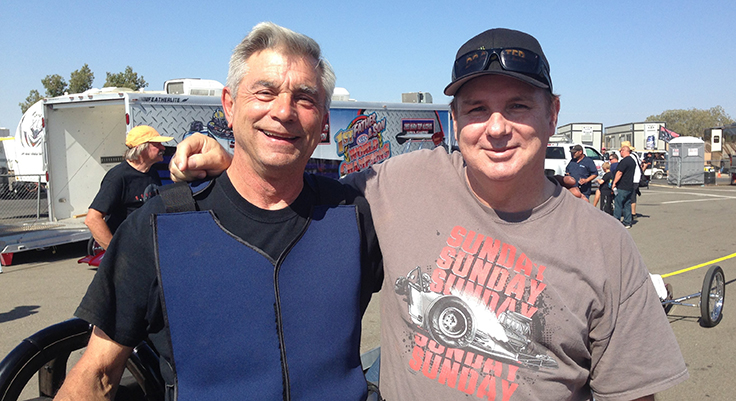
After Frank quit driving (and, later, tuning), I didn’t see him or talk to him for years, which is a crime considering how much the man meant to me and what he and Linda sacrificed to give me the thrill of a lifetime. Frank started driving again in 2014, wheeling Rudy Tomsich's A/Fuel Dragster in nostalgia action, and actually came to the California Hot Rod Reunion that year, where we were able to reunite and relive some of those glorious moments from 30 years earlier. I got the chance to tell him what he meant to me — it’s something I’m trying to practice more and more with my friends — and share a few laughs and some great memories. He's not racing anymore, but working on a street car project and, as he's done forever, still lending a helping hand to anyone who asks. He's an amazing man, one of those people who make your life better by having been a part of it. Well, the same goes for the entire Mazi family. there were and are A-Mazi-ing.
Me, I’ll probably always be known as “the guy that drove the Opel,” which is just fine with me.
Phil Burgess can be reached at pburgess@nhra.com
Hundreds of more articles like this can be found in the DRAGSTER INSIDER COLUMN ARCHIVE
Or try the Random Dragster Insider story generator



















































